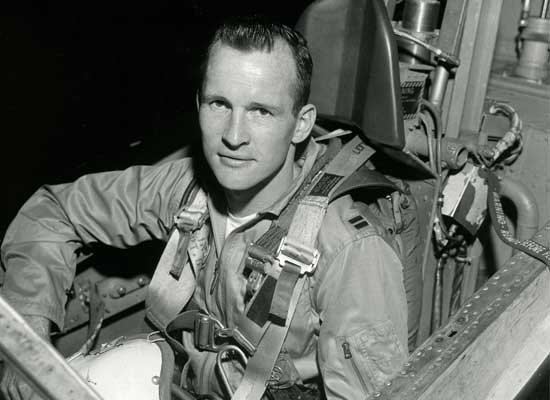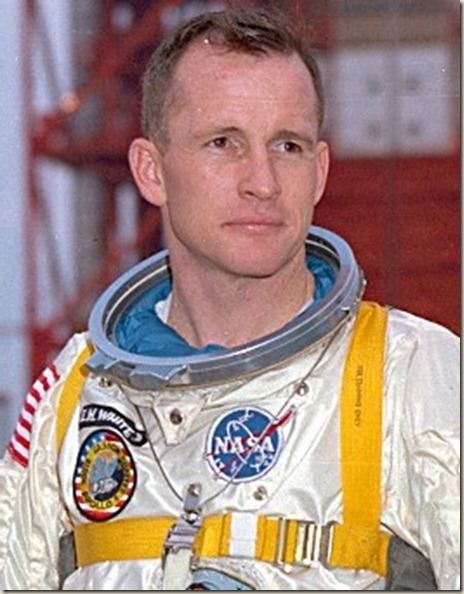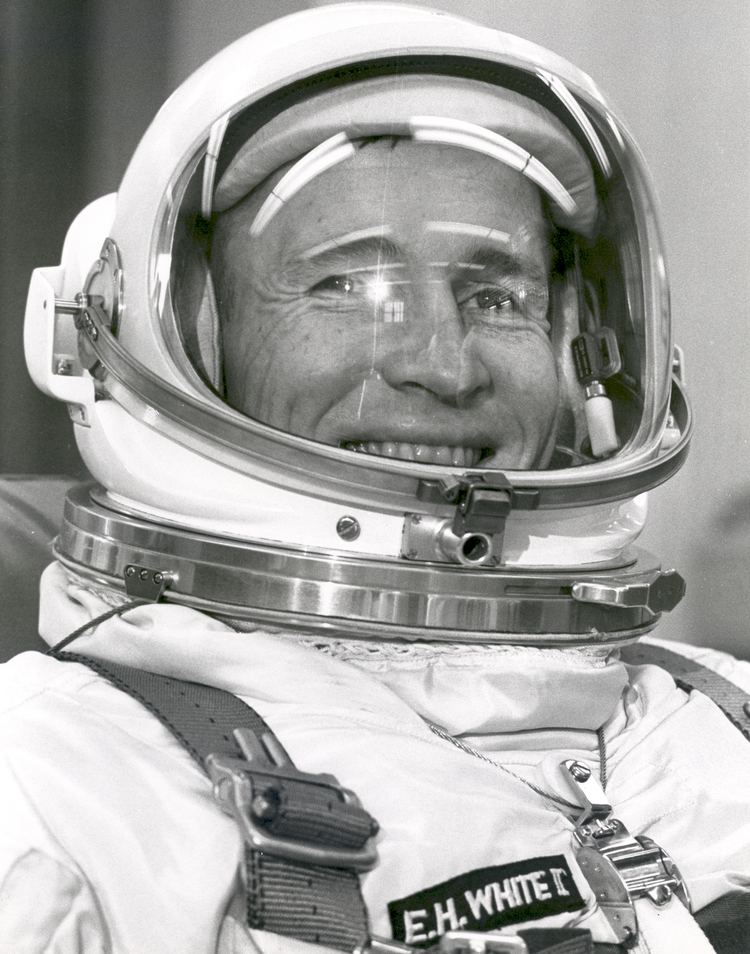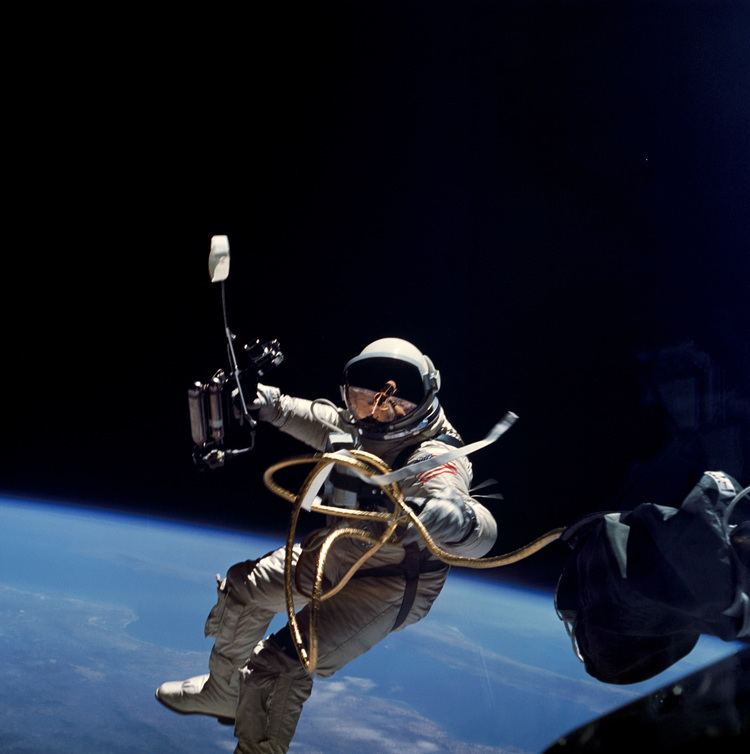Nationality American Name Edward White | Status Killed during training | |
 | ||
Other names Edward Higgins White II Alma mater USMA, B.S. 1952UMich, M.S. 1959 Rank Lieutenant Colonel, USAF Spouse Patricia E. Finegan (m. 1953–1967) Children Edward Higgins White III, Bonnie Lynn White Parents Mary Rosina White, Edward Higgins White, Sr. Similar People | ||
2013 Edward Higgins White
Edward Higgins White II (November 14, 1930 – January 27, 1967), (Lt Col, USAF), was an American aeronautical engineer, U.S. Air Force officer, test pilot, and NASA Astronaut. On June 3, 1965, he became the first American to walk in space. White died along with astronauts Virgil "Gus" Grissom and Roger B. Chaffee during prelaunch testing for the first manned Apollo mission at Cape Canaveral. He was awarded the NASA Distinguished Service Medal for his flight in Gemini 4 and then awarded the Congressional Space Medal of Honor posthumously.
Contents
- 2013 Edward Higgins White
- FIRST MAN On set visit with Jason Clarke Edward Higgins White Corey Stoll Buzz Aldrin
- Early years education and military service
- Project Gemini
- Apollo program
- Death
- Organizations
- Awards and honors
- Schools
- Other sites
- In space
- Philatelic
- Omega Speedmaster Ed White
- In media
- Physical description
- References

FIRST MAN | On-set visit with Jason Clarke "Edward Higgins White" & Corey Stoll "Buzz Aldrin"
Early years, education and military service

White was born on November 14, 1930, in San Antonio, Texas, to parents Edward H. White, Sr. (1901–1978), who became a major general in the U.S. Air Force, and Mary Rosina White (née Haller; 1900–1983). He attended school in his hometown and became a member of the Boy Scouts of America, where he earned the rank of Second Class Scout. After graduation from high school in 1948, he was accepted to the United States Military Academy at West Point, where in 1952 he earned his Bachelor of Science degree and was commissioned as a second lieutenant in the Air Force. Then, he attended flight school, a course that takes just over a year. Following graduation from flight school in 1953, White was assigned to the 22nd Fighter Day Squadron at Bitburg Air Base, West Germany. He spent three and a half years in West Germany flying in F-86 Sabre and F-100 Super Sabre squadrons in the defense of NATO.

After graduating from West Point, White competed for a spot on the U.S. Olympic team in the 400 meter hurdles race. He missed making the team by only 1/10 second. His hobbies included squash, handball, swimming, golf, and photography.

In 1958, White enrolled in the University of Michigan under Air Force sponsorship to study Aeronautical Engineering, where he received his Master of Science degree in 1959. Following graduation, White was selected to attend the U.S. Air Force Test Pilot School at Edwards Air Force Base, California, and following graduation in 1959, he was assigned as a test pilot at the Aeronautical Systems Division at Wright-Patterson Air Force Base, Ohio. During his career, White would log more than 3,000 flight hours with the Air Force, including about 2,200 hours in jets, and would ultimately attain the rank of lieutenant colonel.
In 1953, White married Patricia Finegan, whom he met while at West Point. The Whites would have two children, Edward White III (born 16 September 1953) and Bonnie Lynn White (born 15 May 1956). White was a devout Methodist.
Project Gemini
White was one of nine men chosen as part of the second group of astronauts in 1962. Within an already elite group, White was considered to be a high-flier by the management of NASA. He was chosen as Pilot of Gemini 4, with Command Pilot James McDivitt. White became the first American to make a walk in space, on June 3, 1965. He found the experience so exhilarating that he was reluctant to terminate the EVA at the allotted time, and had to be ordered back into the spacecraft. While he was outside, a spare thermal glove floated away through the open hatch of the spacecraft, becoming an early piece of space debris in low Earth orbit, until it burned up upon re-entry into the Earth's atmosphere. There was a mechanical problem with the hatch mechanism, which made it difficult to open and to relatch, which added to the time constraint of the spacewalk, and could have threatened the lives of both men if McDivitt had been unable to get the hatch latched, as they could not re-enter the atmosphere with an unsealed hatch.
"I'm coming back in... and it's the saddest moment of my life."
White's next assignment after Gemini 4 was as the backup for Gemini 7 Command Pilot Frank Borman. He was also named the astronaut specialist for the flight control systems of the Apollo Command/Service Module. By the usual procedure of crew rotation in the Gemini program, White would have been in line for a second flight as the command pilot of Gemini 10 in July 1966, which would have made him the first of his group to fly twice.
Apollo program
In March 1966 he was selected as senior pilot (second seat) for the first manned Apollo flight, designated AS-204, along with Command Pilot Virgil "Gus" Grissom, who had flown in space on the Mercury 4 Liberty Bell 7 mission and as commander of the Gemini 3 Molly Brown mission, and Pilot Roger Chaffee, who had yet to fly into space. The mission, which the men named Apollo 1 in June, was originally planned for late 1966 (perhaps concurrent with the last Gemini mission), but delays in the spacecraft development pushed the launch into 1967.
Death
Launch of Apollo 1 was planned for February 21, 1967, when the crew entered the spacecraft on January 27, mounted atop its Saturn IB booster on Launch Pad 34 at Cape Kennedy, for a "plugs-out" test of the spacecraft, which included a rehearsal of the launch countdown procedure. Midway through the test, a fire broke out in the pure oxygen-filled cabin, killing all three men.
White's job was to open the hatch cover in an emergency, which he apparently tried to do; his body was found in his center seat, with his arms reaching over his head toward the hatch. Removing the cover to open the hatch was impossible, because the plug door design required venting normally slightly greater-than-atmospheric pressure and pulling the cover into the cabin. Grissom was unable to reach the cabin vent control to his left, where the fire's source was located. The intense heat raised the cabin pressure even more, to the point where the cabin walls ruptured. The astronauts were killed by asphyxiation and smoke inhalation.
The fire's ignition source was determined to be a spark that jumped from a wire on the far left of the spacecraft, under Grissom's seat, but their deaths were attributed to a wide range of lethal hazards in the early Apollo Command Module design and workmanship and conditions of the test, including the highly pressurized 100% oxygen pre-launch atmosphere, many wiring and plumbing flaws, flammable materials used in the cockpit and the astronauts' flight suits, and a hatch which could not be quickly opened in an emergency. After the incident, these problems were fixed, and the Apollo program carried on successfully to reach its objective of landing men on the Moon.
White was buried with full military honors at West Point Cemetery while Grissom and Chaffee are both buried in Arlington National Cemetery.
In 1997, White was posthumously awarded the Congressional Space Medal of Honor. White was inducted into the U.S. Astronaut Hall of Fame in 1993 and the National aviation Hall of Fame on July 18, 2009.
White's wife Patricia remarried and continued to reside in Houston. On September 7, 1983 she committed suicide after surgery earlier in the year to remove a tumor.
Organizations
He was a member of the Society of Experimental Test Pilots; associate member of Institute of Aerospace Sciences; Tau Delta Phi (Engineering Honorary); and Sigma Delta Psi (Athletic Honorary).
Awards and honors
Schools
Many schools have been named in honor of Lt Colonel White:
Other sites
In space
Philatelic
Omega Speedmaster “Ed White”
In media
White was played by Steven Ruge in the 1995 film Apollo 13, by Chris Isaak in the 1998 HBO miniseries From the Earth to the Moon, and by Matt Lanter in the 2015 ABC TV series The Astronaut Wives Club.
